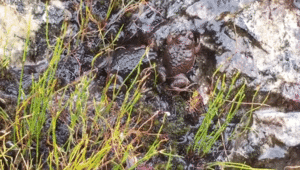Poyntonia facts for kids
Quick facts for kids Poyntonia |
|
|---|---|
| Conservation status | |
| Scientific classification |
The Poyntonia is a special type of frog. It belongs to a family called Pyxicephalidae. This frog group was named after J.C. Poynton. He was a famous expert on reptiles and amphibians in southern Africa.
The Poyntonia paludicola, also known as the Montane Marsh frog, is the only species in this group. It lives only in the Western Cape province of South Africa. You can find these frogs in mountains like Kogelberg, Hottentots-Holland, and Klein River. They live from sea level up to 1,800 meters high. Even though they live in separate groups, there are many of them in the right places. Scientists think these separate groups might be different kinds of frogs. More study is needed to find out.
Contents
What Does the Montane Marsh Frog Look Like?
The Montane Marsh frog (P. paludicola) looks a bit like a toad. It has a strong body and bumpy skin. Adult frogs are about 27 to 30 millimeters long. That's about the size of a large paperclip! Female frogs are usually bigger than males.
You cannot see their eardrum, called the tympanum. Their fingers have a little bit of webbing. Their toes are long and do not have sticky pads. Small bumps, called warts, cover most of their body. They also have a raised bumpy area behind each eye.
Many of these frogs have a red-orange stripe down their back. Most also have a long, white, teardrop-shaped mark. This mark goes from the bottom of their eye to the top of their arm. Their belly is light-colored. It often has dark spots scattered unevenly.
How Does the Montane Marsh Frog Call?
The male frog's call is unique. It sounds like a rough "kruck-kruck-kruck." They make 1 to 6 short, low-pitched chirps. They chirp about three times every second.
What About Their Eggs?
The eggs of the Montane Marsh frog are quite large. They are big compared to the size of the adult frog. In September 2020, one group of eggs was found. It had 15 eggs. These eggs were laid at the edge of a muddy puddle. The water was only about 2 centimeters deep. The eggs and young tadpoles of Poyntonia are similar to another frog group. This group is called Capensibufo. They are small mountain toads that live in similar places.
Where Does the Montane Marsh Frog Live?
The Montane Marsh frog lives in mountain fynbos areas. Fynbos is a type of shrubland with many small bushes. It is found in places with a Mediterranean climate. These areas get a lot of rain, about 2,000 to 3,000 millimeters each year. The frogs live from sea level up to 1,800 meters high.
Where Do They Lay Eggs?
These frogs lay their eggs in shallow puddles. These puddles are often found in areas where water seeps out of the ground. Sometimes, there is a gentle flow of water in these seepage areas.
What Threats Do They Face?
The places where these frogs live are facing some problems.
- New plants that don't belong there are growing. These are called alien species.
- Too much water is being taken from their habitat.
- Natural fires are not happening as they should.
Luckily, most of these frog groups live in protected areas. These include the Kogelberg Biosphere Nature Reserve, Hottentots Holland Nature Reserve, and Fernkloof Nature Reserve.
Life Cycle and Behavior
Most of the Montane Marsh frogs breed during the winter months. This is from June to September. However, male frogs will call at any time of year. They just need the weather conditions to be right.
Daily Life of the Frog
This species is diurnal. This means they are active during the day. You can find frogs of all ages during daylight hours. They are often out in the open in their wet seepage areas. Male frogs start calling when the sun rises. They continue calling into the evening.
Where Are the Tadpoles?
Frog eggs have been found in very shallow puddles. They are often under a thin layer of mud. The young tadpoles live on the bottom of the water. This is called being benthic. They will hide in the mud if they feel disturbed.
How Do They Handle Challenges?
Fires do not seem to affect their breeding much. Frogs have been heard calling after the first good rains following a fire. Also, these frogs can handle some human changes to their habitat. Frogs have been found in eroded areas. They also live in drainage ditches next to jeep tracks. These tracks cut through their seepage areas.
Male frogs have been seen fighting during breeding season. This is similar to how African Bullfrogs fight.



